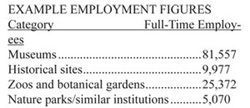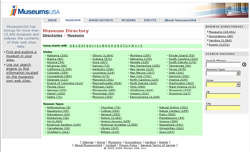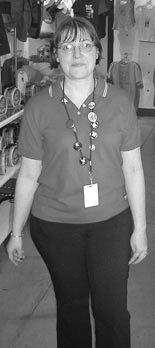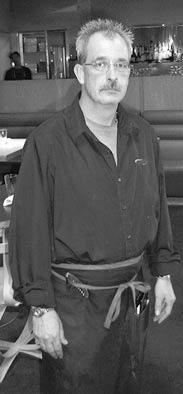|
By Chelan David Museums represent a huge potential windfall for apparel makers. Not only do many museums house retail stores that sell T-shirts, sweatshirts and a myriad of other clothing items, but they are flush with a variety of employees who wear different uniforms. When targeting the museum market for apparel sales, it is important to define what is classified as a museum. The American Association of Museums (AAM) counts their members including both government and private museums of anthropology, art history and national history, aquariums, botanical gardens, planetariums, science centers and zoos. The common denominator is that each institution is making a unique contribution to the public by collecting, preserving and interpreting the things of this world. Combined, these various types of museums account for over 850 million visits per year. How many total museums are there in the United States? AAM cant say with certainty as it is aware of only two attempts to count each and every museum, but both independent studies pegged the number between 15,500 and 16,000. Museums vary greatly by size, content and number of employees, but the majority have uniform needs in at least the following areas: guest services, ticketing, retail, security and maintenance. Larger ones will also have a host of food and beverage employees, docents, coat checkers and parking attendants. One doesnt have to be a mathematician to realize that there is a significant amount of opportunities in providing museums with a host of different uniforms. The Experience Music Project (EMP) in Seattle is a relative newcomer to the museum ranks. The 140,000-square-foot space, designed by renowned architect Frank Gehry, opened in June of 2000. The museum celebrates the innovation and creativity in music of all kinds by combining artifacts of various genres with an interactive experience. EMP is the pet project of Paul Allen, a co-founder of Microsoft, and as can be expected, it is decidedly high-tech. Visitors to the museum use interactive personal headphones as they view the exhibits. The Sound Lab, where guests can pretend they are rock stars, is brimming with the latest in musical gear and audio technology.
While many of the museums offerings are futuristic, the staffs uniforms are purely functional. Serving the needs of over 400,000 visitors requires nearly 250 employees in a variety of departments, all wearing different uniform components. When choosing uniform designs, Connie Schneider, EMPs director of guest services, looks for functionality first. Garments must be comfortable and easily identify each staff members position so visitors will know who to appropriately direct their questions to. The museums culture also plays a role in the purchasing decision. Schneider describes the environment as upbeat, youthful and musically oriented. We look for a quality uniform that is appealing and creative, she says. We want our guests to have a quality impression of their entire museum experience including how our staff is dressed. Visitors to the museum are likely to encounter employees from a number of different departments. The one accessory they all have in common is a photo name badge which is protected by a plastic sleeve. The building has secured access points for employees, so the tag doubles as a security pass. EMP provides every employee with two uniforms each, which consist of a shirt, the name badge and, for the food and beverage workers, aprons. The workers are responsible for providing pants, which for most of the departments, are either black slacks or black jeans. When visitors arrive at EMP, a multi-hued steel structure located in the heart of Seattle, the first staff members they encounter are guest service representatives and ticket agents. Sharing close quarters at the entrance of the museum, they are the only two departments that wear the same uniform: 100% cotton blue shirts with the EMP logo on the sleeves. The shirts feature a button-up front and have a boxy cut with small slits on the sides. On the back, Guest Services is printed in black lettering to make their role easily identifiable. Since opening more than five years ago, many new uniforms have been ordered but the overall styles have remained consistent. There are several exceptions however. The employees on the front line, such as ticketing and guest services, who are most often seen by returning visitors to the museum have had their uniforms changed several times. Schneider says this is so the public doesnt see the same uniforms over and over and, along with the special exhibits, helps to keep the experience fresh. Also, maintenance uniforms, which were initially purchased in-house, are now outsourced, a move that was accompanied by a change in design. Schneider currently works with multiple vendors for providing the remainder of the uniforms but hopes to eventually consolidate with one apparel vendor in an effort to secure the most efficient prices. Since assuming her current role in the fall of 2004, she has helped place several orders and expects the museum to average three to four orders each year. The managers of each department are responsible for ordering and storing their groups uniforms, but they work closely with Schneider, and in addition to allocating budgets, she must approve all design changes. Recently, the bar manager, retail manager and Schneider worked hand-in-hand to place a new shirt order for the bar employees. A button-down bowling style shirt had just arrived at the museums retail store, and the bar manager was instantly smitten with the basic design but wanted a few minor adjustments to the shirt. Borrowing the shirt from the retail manager, he worked with Schneider, who in turn enlisted the help of an existing apparel vendor to custom tailor the shirt. The black bowling shirt, with subtle stripes and an EMP logo was created. Paired with black aprons, the shirts imbue a 1950s diner coolness with a modern edge. From the initial idea to the arrival of the new bar shirts, the undertaking took only about six weeks. We knew exactly what we wanted so this project went very quickly, says Schneider, who acknowledges that the process of designing new uniform components usually takes longer. Turntable, the name of the museums restaurant which is situated directly below the bar, features several flat-screen television monitors and has a menu full of American regional dishes. Waiters wear button-down, black long-sleeved cotton shirts featuring an embroidered logo on the left chest that matches the red buttons. The waiters aprons are larger than the style their peers in the bar wear. Schneider says the sheer magnitude of options involving such items as aprons is staggering. When we look through apparel books, there must be 100 styles of aprons: long, short, with pockets, without pockets and on and on, she explains. When making uniform selections, Schneider and her colleagues thumb through magazines and apparel books before contacting vendors. While Schneider and the managers are ultimately responsible for picking the uniforms, they appreciate feedback from the staff. Ultimately they are the ones who have to feel comfortable in them, she points out. While most of the comments have been positive, one common complaint among guest services and ticketing employees is that the shirts wrinkle easily. The employees are responsible for laundering the garments as well as keeping them wrinkle free. The museum does not conduct any wear tests on the uniforms to make sure they meet specific standards. Schneider expects each apparel vendors that EMP does business with to make sure all garments ordered are sturdy and suitable for multiple washes. The cleaning crew, which is responsible for dusting off displays containing the likes of KISS costumes complete with spiked knee-high boots and James Browns stage jacket and cape, wear decidedly utilitarian costumes. The housekeepers uniform is a practical combination of white cotton and polyester blended t-shirts paired with blue jeans. Outsourced to Advanced Cleaning Services, the T-shirts have the name of the cleaning company screen printed on the back. Rounding out the employee uniforms on display at EMP are the retail and security staffs. Workers in the retail store wear cotton knit polo shirts, and the uniform varies by gender; males wear gray and females wear red. Security, armed with walkie-talkies, sport black cotton shirts with security embroidered on the back in big, bold lettering. Schneider, however, has been surprised by the dearth of vendors who have contacted her since she moved to EMP from the hotel industry. She even recounts having to ask one of her advertising vendors to refer an apparel vendor when she first started. When I was the general manager of a hotel, I received many more solicitations in regards to uniforms, she says. People realize that there are a lot of uniform needs for hotels, but an apparel vendor could make a lot of money by targeting museums. Her advice for uniform dealers that are interested in tapping into the museum market? Do some homework on museums in general, she recommends. Then specifically target the ones that you would like to do business with and know what types of uniforms they are in need of.
|
|
| Above story first appeared in MADE TO MEASURE Magazine, Fall & Winter 2005 issue. All rights reserved. Photos appear by special permission. | |
| Halper Publishing Company 633 Skokie Blvd, #490 Northbrook, IL 60062 (847) 780-2900 Fax (224) 406-8850 [email protected] |
|















